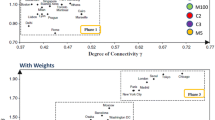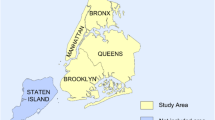Abstract
Agencies at the federal, state and local level are aiming to enhance the public transportation system (PTS) as one alternative to alleviate congestion and to cater to the needs of captive riders. To effectively act as a viable alternative transportation mode, the system must be highly efficient. One way to measure efficiency of the PTS is connectivity. In a multimodal transportation system, transit is a key component. Transit connectivity is relatively complex to calculate, as one has to consider fares, schedule, capacity, frequency and other features of the system at large. Thus, assessing transit connectivity requires a systematic approach using many diverse parameters involved in real-world service provision. In this paper, we use a graph theoretic approach to evaluate transit connectivity at various levels of service and for various components of transit, such as nodes, lines, and transfer centers in a multimodal transportation system. Further, we provide a platform for computing connectivity over large-scale applications, using visualization to communicate results in the context of their geography and to facilitate public transit decision-making. The proposed framework is then applied to a comprehensive transit network in the Washington-Baltimore region. Underpinning the visualization, we introduce a novel spatial data architecture and Web-based interface designed with free and open source libraries and crowd-sourced contextual data, accessible on various platforms such as mobile phones, tablets and personal computers. The proposed methodology is a useful tool for both riders and decision-makers in assessing transit connectivity in a multimodal transit network in a number of ways such as the identification of under-served transit areas, prioritization and allocation of funds to locations for improving transit service.









Similar content being viewed by others
Abbreviations
- \( D_{l}^{i} \) :
-
Inbound distance of link l
- \( D_{l}^{o} \) :
-
Outbound distance of link l from node n to destination
- F l :
-
Frequency of line l
- H l :
-
Daily hours of operation of l
- \( L_{{n,n_{1} }} \) :
-
Shortest distance between node n 1 to n
- \( P_{l,n}^{i} \) :
-
Inbound connecting power of link l
- \( P_{l.n}^{o} \) :
-
Outbound connecting power of link l
- \( P_{l,n}^{t} \) :
-
Total connecting power of line l at node n
- S R :
-
Set of stops in region R
- S l :
-
Set of stops in line l
- S σ :
-
Set of stops in region center σ
- V l :
-
Average speed of link l
- n 0 :
-
Initial stop
- \( t_{{n_{1} ,n}} \) :
-
Transfer time from n 1 to n
- \( \delta_{{n_{1} ,n_{2} }} \) :
-
Total number of paths between n 1 and n 2
- \( \delta_{{n_{1} ,n_{2} }} (n) \) :
-
Number of paths exist between n 1 and n 2 those pass through n
- \( \delta_{np} \) :
-
A binary indicator variable for determining the degree centrality, which takes the value of 1 when node p is dependent on n, and 0 otherwise
- \( \theta_{R} \) :
-
Connectivity index for region R
- \( \theta_{l} \) :
-
Connectivity index for line l
- \( \theta_{n} \) :
-
Connectivity index for node n
- \( \rho_{{n_{1} ,n}} \) :
-
Passenger acceptance rate from node n 1 to n
- \( \rho_{R} \) :
-
Density measure for region R
- a :
-
Parameter for passenger acceptance rate
- b :
-
Parameter for passenger acceptance which is sensitive to travel time
- L :
-
Link
- N :
-
Node
- N :
-
Network system
- P :
-
Node dependent on n
- α :
-
Scaling factor coefficient for capacity of line l
- β :
-
Scaling factor coefficient for speed of line l
- γ :
-
Scaling factor coefficient for distance of line l
- A l,n :
-
Activity density of line l, at node n
- \( \vartheta \) :
-
Scaling factor for activity density
- \( E_{l,n}^{z} \) :
-
Number of households in zone z containing line l and node n
- \( E_{l,n}^{z} \) :
-
Employment for zone z containing line l and node n
- \( \varTheta_{l,n}^{z} \) :
-
Area of z containing line l and node
- \( \varTheta_{l}^{n} \) :
-
Number of lines l at node n
References
Ahmed A, Dwyer T, Forster M et al (2006) GEOMI: GEOmetry for Maximum Insight. In: Healy P, Nikolov NS (eds) Graph drawing. Springer, Berlin, pp 468–479
Aittokallio T, Schwikowski B (2006) Graph-based methods for analysing networks in cell biology. Brief Bioinform 7:243–255. doi:10.1093/bib/bbl022
Barthlemy M (2004) Betweenness centrality in large complex networks. Eur Phys J B Condens Matter 38:163–168. doi:10.1140/epjb/e2004-00111-4
Bell DC, Atkinson JS, Carlson JW (1999) Centrality measures for disease transmission networks. Soc Netw 21:1–21 pii: 16/S0378-8733(98)00010-0
Bonacich P (2007) Some unique properties of eigenvector centrality. Soc Netw 29:555–564 pii: 16/j.socnet.2007.04.002
Bonacich P, Lloyd P (2001) Eigenvector-like measures of centrality for asymmetric relations. Soc Netw 23:191–201 pii: 16/S0378-8733(01)00038-7
Borgatti SP (2005) Centrality and network flow. Soc Netw 27:55–71 pii: 16/j.socnet.2004.11.008
Brandes U (2001) A faster algorithm for betweenness centrality. J Math Sociol 25:163–177. doi:10.1080/0022250X.2001.9990249
Carrington PJ, Scott J, Wasserman S (2005) Models and methods in social network analysis. Cambridge University Press, Cambridge
Ceder A, Net YL, Coriat C (2009) Measuring public transport connectivity performance applied in Auckland, New Zealand. Transp Res Record J Transp Res Board 2111:139–147
Costenbader E, Valente TW (2003) The stability of centrality measures when networks are sampled. Soc Netw 25:283–307 pii: 16/S0378-8733(03)00012-1
Crucitti P, Latora V, Porta S (2006) Centrality in networks of urban streets. Chaos 16:015113. doi:10.1063/1.2150162
Derrible S, Kennedy C (2009) Network analysis of world subway systems using updated graph theory. Transp Res Record J Transp Res Board 2112:17–25. doi:10.3141/2112-03
Estrada E, Rodríguez-Velázquez JA (2005) Subgraph centrality in complex networks. Phys Rev E 71:056103. doi:10.1103/PhysRevE.71.056103
Freeman LC (1978) Centrality in social networks conceptual clarification. Soc Netw 1:215–239 pii: 16/0378-8733(78)90021-7
Garroway CJ, Bowman J, Carr D, Wilson PJ (2008) Applications of graph theory to landscape genetics. Evol Appl 1:620–630. doi:10.1111/j.1752-4571.2008.00047.x
Goh K-I, Oh E, Kahng B, Kim D (2003) Betweenness centrality correlation in social networks. Phys Rev E 67:017101. doi:10.1103/PhysRevE.67.017101
Guimerà R, Mossa S, Turtschi A, Amaral LAN (2005) The worldwide air transportation network: anomalous centrality, community structure, and cities’ global roles. Proc Natl Acad Sci USA 102:7794–7799. doi:10.1073/pnas.0407994102
Hadas Y, Ceder A (2010) Public transit network connectivity. Transp Res Record J Transp Res Board 2143:1–8. doi:10.3141/2143-01
Hadas Y, Ceder A, Ranjitkar P (2011) Modeling public-transit connectivity with quality-of-transfer measurements
Jiang B, Claramunt C (2004) A structural approach to the model generalization of an urban street network. GeoInformatica 8:157–171. doi:10.1023/B:GEIN.0000017746.44824.70
Junker B, Koschutzki D, Schreiber F (2006) Exploration of biological network centralities with CentiBiN. BMC Bioinform 7:219. doi:10.1186/1471-2105-7-219
Lam TN, Schuler HJ (1982) Connectivity index for systemwide transit route and schedule performance. Transp Res Rec 854:17–23
Latora V, Marchiori M (2007) A measure of centrality based on network efficiency. New J Phys 9:188. doi:10.1088/1367-2630/9/6/188
Liu X, Bollen J, Nelson ML, Van de Sompel H (2005) Co-authorship networks in the digital library research community. Inf Process Manage 41:1462–1480 pii: 16/j.ipm.2005.03.012
Martinez KLH, Porter BE (2006) Characterizing red light runners following implementation of a photo enforcement program. Accid Anal Prev 38:862–870. doi:10.1016/j.aap.2006.02.011
Mishra S, Welch TF, Jha MK (2012) Performance indicators for public transit connectivity in multi-modal transportation networks. Transp Res Part A Policy Pract 46:1066–1085. doi:10.1016/j.tra.2012.04.006
Moore S, Eng E, Daniel M (2003) International NGOs and the role of network centrality in humanitarian aid operations: a case study of coordination during the 2000 Mozambique floods. Disasters 27:305–318. doi:10.1111/j.0361-3666.2003.00235.x
Newman MEJ (2004) Analysis of weighted networks. Phys Rev E 70:056131. doi:10.1103/PhysRevE.70.056131
Newman MEJ (2005) A measure of betweenness centrality based on random walks. Soc Netw 27:39–54 pii: 16/j.socnet.2004.11.009
Opsahl T, Agneessens F, Skvoretz J (2010) Node centrality in weighted networks: generalizing degree and shortest paths. Soc Netw 32:245–251 pii: 16/j.socnet.2010.03.006
Otte E, Rousseau R (2002) Social network analysis: a powerful strategy, also for the information sciences. J Inf Sci 28:441–453. doi:10.1177/016555150202800601
Özgür A, Vu T, Erkan G, Radev DR (2008) Identifying gene-disease associations using centrality on a literature mined gene-interaction network. Bioinformatics 24:i277–i285. doi:10.1093/bioinformatics/btn182
Park J, Kang SC (2011) A model for evaluating the connectivity of multimodal transit networks. Transportation Research Board 90th annual meeting
Ruhnau B (2000) Eigenvector-centrality—a node-centrality? Soc Netw 22:357–365 pii: 16/S0378-8733(00)00031-9
White HD (2003) Pathfinder networks and author cocitation analysis: a remapping of paradigmatic information scientists. J Am Soc Inform Sci Technol 54:423–434. doi:10.1002/asi.10228
White DR, Borgatti SP (1994) Betweenness centrality measures for directed graphs. Soc Netw 16:335–346 pii: 16/0378-8733(94)90015-9
Author information
Authors and Affiliations
Corresponding author
Electronic supplementary material
Below is the link to the electronic supplementary material.
Rights and permissions
About this article
Cite this article
Mishra, S., Welch, T.F., Torrens, P.M. et al. A tool for measuring and visualizing connectivity of transit stop, route and transfer center in a multimodal transportation network. Public Transp 7, 77–99 (2015). https://doi.org/10.1007/s12469-014-0091-2
Published:
Issue Date:
DOI: https://doi.org/10.1007/s12469-014-0091-2




